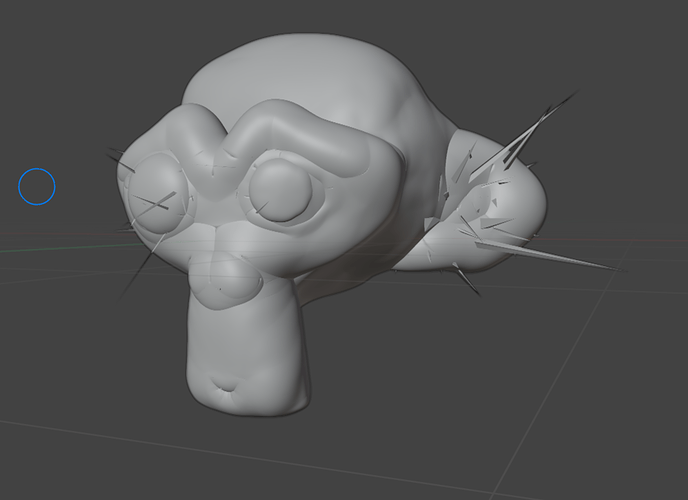This is 3.5 alpha. Suzanne triangulated, Inflate brush. It involved some skipping through the sculpt mode levels low to high to appear. But its still there.
hmm yeah it seems to still have problems with propagating ‘extreme’ changes to higher levels. Was able to reproduce now.
Havent tested it in a while, but I think that it feels more stable with regular meshes. Have there been updates?
Not that I know of since Pablo Dobarro and Sergey fixed the subdivide algorithm. Maybe that did make it more stable. Have been busy getting my CS degree so I was hoping to find the time to study the source code and get a couple of bugfixes in if I find the time…
The spikes also start to appear when switching to edit-mode and back to sculpt mode. Very strange. Yeah this is still unusable. How does the Blender Studio handle this? As far as I know they used the multires in their latest project Charge?
Yes maybe the last improvements reach back so far. Congrats on the CS degree. ![]() Honestly I dont know if they used it in charge, but it definitely is in need of some fixes.
Honestly I dont know if they used it in charge, but it definitely is in need of some fixes.
I can confirm that we used multires sculpting a lot in Charge. Stability was not an issue if the mesh is clean enough, so I only used N-poles, E-poles and quads. I think Sergey fixed all major issues a couple years back.
During Charge there was struggling with known issues, like performance on switching levels & modes and some brush settings & operators not being properly supported.
But overall it did the job. All the issues are well known and will hopefully be addressed after Dyntopo has been reworked. I think it’s fair to say that multires and any related feature like layered sculpting is the biggest blind spot in Blenders sculpting toolset right now.
So with N and E poles only there were no spikes? Overall these are great news, the question is just about the current state.
What is an E-pole? Never came across that term before. Is it the same as a 3-pole (basically an [edge-] valence three vertex)?
greetings, Kologe
E is valence of five N is three.
N pole = 3 pole
E pole = 5 pole
I just looked them up again and the names apparently come from “Extrude” and “Nose”.
Seems arbitrary since both cases of an extrusion and topology around a nose will likely have both an E and N pole.
I always assumed that the letters correlate to the number of edges that they are made of haha
N are 3 lines and E are 5 lines.
I think the biggest blindspot is actually the propagation in the multires. This effects the predictability of the entire workflow as well as any future features like layers as these all depend on it. IMO this should be the first thing on the list when revisiting the multires code and will probably make supporting attribute painting and layers more straightforward.
Thanks for the info. I thought ‘N-pole’ was kind of equivalent to ‘N-gon’, thus that’d be the 5-pole.
Does this make sense to anyone? If I’d extrude a single quad, it’d have 3-poles around said extruded quad, but also 5-poles where the extrusion connects to the surrounding geo. ![]()
Well, only if you split the vertical line in the E like a seven-segment display does. ![]()
Note to self: Evangelize everybody to just call it 3-pole and 5-pole.
Sry for the offtopic.
greetings, Kologe
Creases seem to make the spikes appear, especially if they end in a pole. Can’t really replicate it, but it happens frequently enough.
Probably not a high priority, since I’ve never heard or seen anyone use creases when sculpting in Blender ![]()
Yes, same here! ![]() Although you could argue that an ‘E’ contains four lines.
Although you could argue that an ‘E’ contains four lines. ![]() But 3D people like us look at the ‘E’ as five edges connected with vertices.
But 3D people like us look at the ‘E’ as five edges connected with vertices. ![]()
This is one of those things I’ve never consciously considered until you explained it… but yeah, in my head, E’s have five lines. It just feels weird to look at them any other way. Everyone else would say they have four lines though. So are we the crazy ones, or is everyone else? ![]()
The answer is ALWAYS everyone else. ![]()
From the old subdivisionmodeling.com archive
The E was short for extrude - when you extrude a quad it results in 4 E poles and 4 N poles
The N was short for Nose - from the resulting pole that MUST always be present when modeling the nose
None of this was ‘official’ terminology of course, it just became common in the good old days of boxmodeling organic forms. ![]()
Not forgetting the EN pole configuration, of course…

So if you handwrite a capital E, do you actually stop in the middle of the vertical line, such as to make two distinct line segments? ![]()
Hey all! I’ve put some work into rewriting the user manual to better explain the current sculpt mode features.
A new comprehensive introduction of the major features,
clear & helpful descriptions of brushes and tools
and making the text more friendly towards users.
I could use your help for adding various helpful tips on how to use brushes/tools and operators,
combining them to create unique effects, or any other tips and workflows that aren’t obvious
or are hard to find on the webs.
Any ideas or feedback is very welcome ![]()
Here are some examples. The Grab brush is the most complete page right now in terms of helpful content and visual examples. More to come soon.
https://docs.blender.org/manual/en/dev/sculpt_paint/sculpting/tools/grab.html
https://docs.blender.org/manual/en/dev/sculpt_paint/sculpting/introduction/index.html
https://docs.blender.org/manual/en/dev/sculpt_paint/sculpting/toolbar.html

